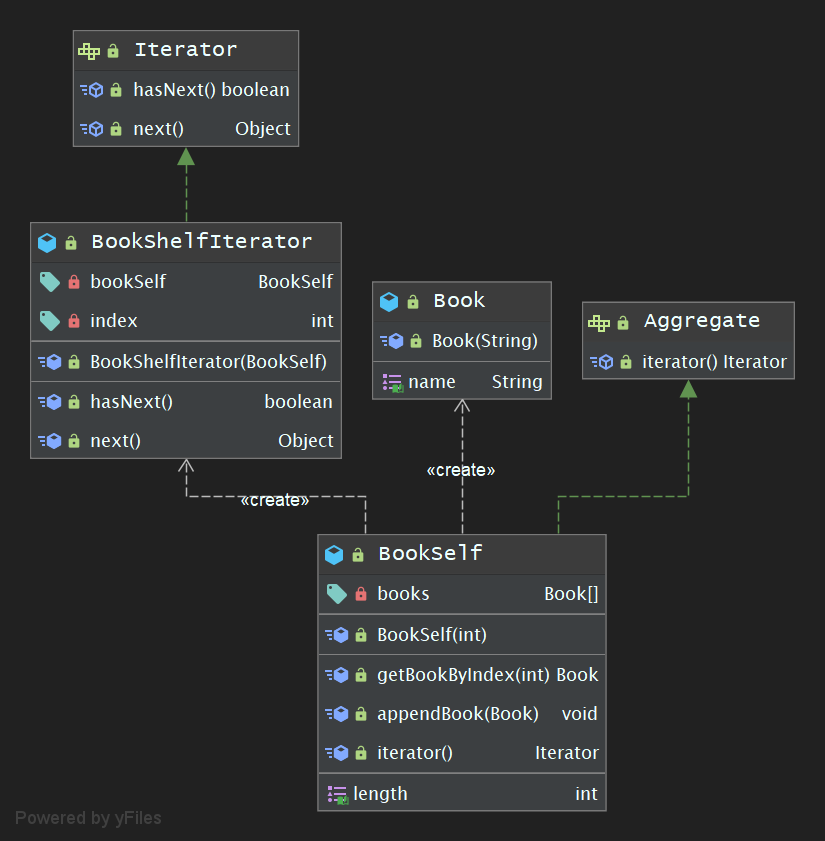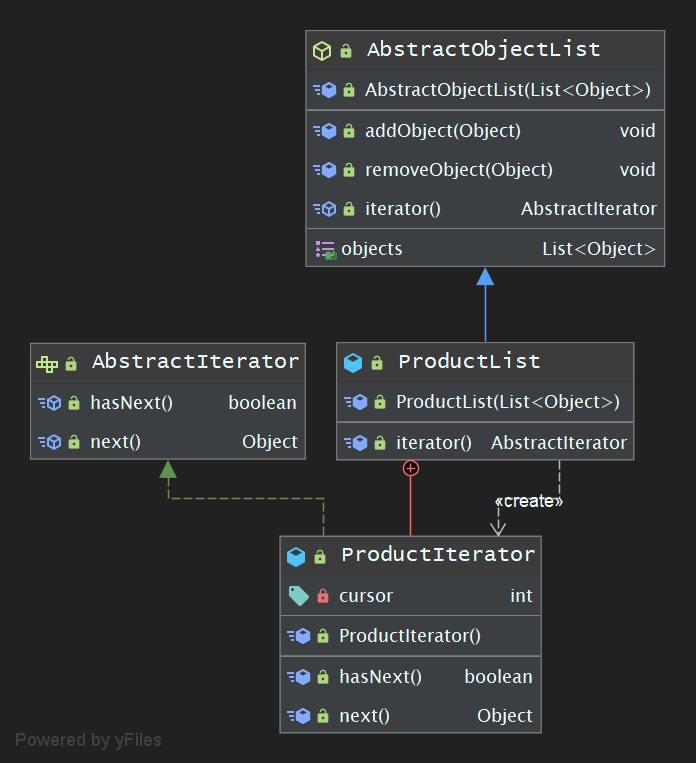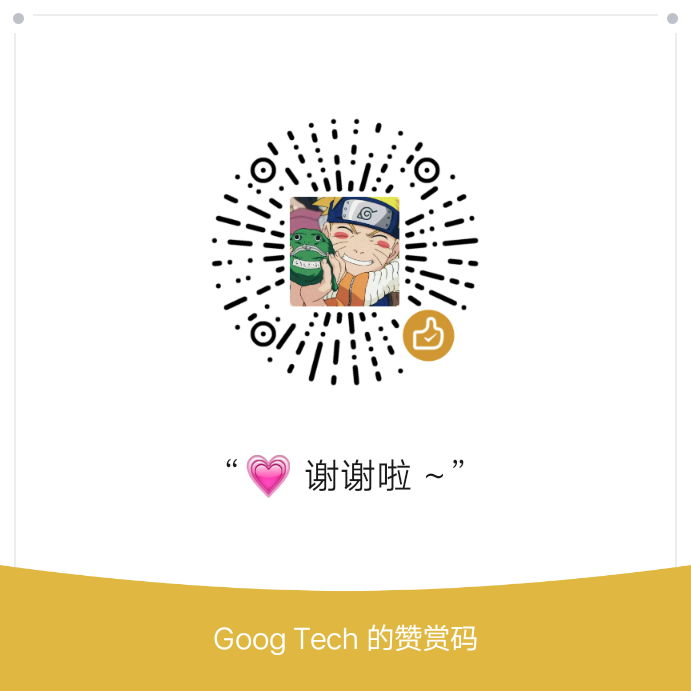学习笔记 : Java设计模式之Iterator模式
概述
迭代器模式 : 提供一种方法顺序访问一个聚合对象中的各个元素,而又不暴露该对象的内部表示. 迭代器模式又称( Cursor )模式,它是一种对象行为型模式( Iterator Pattern : Provide a way to access the elements of an aggregate object sequentially without exposing its underlying representation )
示例程序-详细版
下面是一个实现了Iterator模式的示例程序,其作用是将书籍信息( Book )放到存储书籍信息的书架( BookSelf )上,并将书的名字按顺序显示出来
Book : 图书信息类
1
2
3
4
5
6
7
8
9
10
11
12
13
14
15
16
17
18
19
20
21
22
23package pers.huangyuhui.iterator;
/**
* @project: design-patterns
* @description: Book信息
* @author: 黄宇辉
* @date: 9/2/2019-4:59 PM
* @version: 1.0
* @website: https://yubuntu0109.github.io/
*/
public class Book {
private String name;
public Book(String name) {
this.name = name;
}
public String getName() {
return name;
}
}Aggregate接口 : 充当集合角色
1
2
3
4
5
6
7
8
9
10
11
12
13
14
15package pers.huangyuhui.iterator;
/**
* @project: design-patterns
* @description: 集合
* @author: 黄宇辉
* @date: 9/2/2019-5:00 PM
* @version: 1.0
* @website: https://yubuntu0109.github.io/
*/
public interface Aggregate {
Iterator iterator();
}BookSelf类 : 充当具体的集合角色
1
2
3
4
5
6
7
8
9
10
11
12
13
14
15
16
17
18
19
20
21
22
23
24
25
26
27
28
29
30
31
32
33
34
35package pers.huangyuhui.iterator;
/**
* @project: design-patterns
* @description: 具体的集合
* @author: 黄宇辉
* @date: 9/2/2019-5:03 PM
* @version: 1.0
* @website: https://yubuntu0109.github.io/
*/
public class BookSelf implements Aggregate {
private Book[] books;
private int last = 0;
public BookSelf(int maxsize) {
this.books = new Book[maxsize];
}
public Book getBookByIndex(int index) {
return books[index];
}
public void appendBook(Book book) {
this.books[last++] = book;
}
public int getLength() {
return last;
}
public Iterator iterator() {
return new BookShelfIterator(this);
}
}Iterator接口 : 充当迭代器角色
1
2
3
4
5
6
7
8
9
10
11
12
13
14
15package pers.huangyuhui.iterator;
/**
* @project: design-patterns
* @description: 迭代器
* @author: 黄宇辉
* @date: 9/2/2019-5:01 PM
* @version: 1.0
* @website: https://yubuntu0109.github.io/
*/
public interface Iterator {
boolean hasNext();
Object next();
}BookShelfIterator类 : 充当具体的迭代器角色
1
2
3
4
5
6
7
8
9
10
11
12
13
14
15
16
17
18
19
20
21
22
23
24
25
26
27
28
29
30package pers.huangyuhui.iterator;
/**
* @project: design-patterns
* @description: 集体的迭代器
* @author: 黄宇辉
* @date: 9/2/2019-5:07 PM
* @version: 1.0
* @website: https://yubuntu0109.github.io/
*/
public class BookShelfIterator implements Iterator {
private BookSelf bookSelf;
private int index;
public BookShelfIterator(BookSelf bookSelf) {
this.bookSelf = bookSelf;
this.index = 0;
}
public boolean hasNext() {
return index < bookSelf.getLength();
}
public Object next() {
return bookSelf.getBookByIndex(index++);
}
}Test测试类
1
2
3
4
5
6
7
8
9
10
11
12
13
14
15
16
17
18
19
20
21
22
23
24
25
26
27package pers.huangyuhui.iterator;
/**
* @project: design-patterns
* @description: 测试类
* @author: 黄宇辉
* @date: 9/2/2019-5:09 PM
* @version: 1.0
* @website: https://yubuntu0109.github.io/
*/
public class Test {
//demo
public static void main(String[] args) {
BookSelf bookSelf = new BookSelf(5);
bookSelf.appendBook(new Book("A-BOOK"));
bookSelf.appendBook(new Book("B-BOOK"));
bookSelf.appendBook(new Book("C-BOOK"));
bookSelf.appendBook(new Book("D-BOOK"));
bookSelf.appendBook(new Book("E-BOOK"));
Iterator iterator = bookSelf.iterator();
while (iterator.hasNext()) {
Book book = (Book) iterator.next();
System.out.println(book.getName());
}
}
}程序运行结果如下所示 :
1
2
3
4
5A-BOOK
B-BOOK
C-BOOK
D-BOOK
E-BOOK
示例程序的类图

Iterator模式中的角色分析
Iterator( 迭代器 ): 该角色负责定义按顺序逐个遍历元素的接口( API ),在上述程序中,由Iterator接口扮演此角色.ConcreteIterator( 具体的迭代器 ): 该角色负责实现Iterator角色所定义的接口( API ). 在上述程序中,由BookShelfIterator类扮演此角色.Aggregate( 集合 / 抽象聚合类 ): 该角色负责定义创建Iterator角色的接口( API ),在上述程序中,由Aggregate接口扮演此角色.ConcreteAggregate( 具体的集合 / 具体聚合类 ): 该角色负责实现Aggregate角色所定义的接口( API ),它会创建出具体的Iterator角色. 在上述程序中,由BookSelf类扮演了此角色.
示例程序-简洁版
下面同样是一个实现了Iterator模式的示例程序( 同上 ),其作用是将商品数据存储到商品集合( ProductList )中,并将商品的名字按顺序显示出来
AbstractObjectList : 抽象聚合类
1
2
3
4
5
6
7
8
9
10
11
12
13
14
15
16
17
18
19
20
21
22
23
24
25
26
27
28
29
30
31
32
33
34
35
36package pers.huangyuhui.iterator2;
import java.util.List;
/**
* @project: design-patterns
* @description: 抽象聚合类
* @author: 黄宇辉
* @date: 9/2/2019-5:51 PM
* @version: 1.0
* @website: https://yubuntu0109.github.io/
*/
public abstract class AbstractObjectList {
protected List<Object> objects;
public AbstractObjectList(List<Object> objects) {
this.objects = objects;
}
public void addObject(Object object) {
this.objects.add(object);
}
public void removeObject(Object object) {
this.objects.remove(object);
}
public List<Object> getObjects() {
return objects;
}
//创建迭代器的抽象工厂方法
public abstract AbstractIterator iterator();
}ProductList : 商品数据类,充当具体聚合类. ProductIterator(内部类) : 商品迭代器,充当具体迭代器
1
2
3
4
5
6
7
8
9
10
11
12
13
14
15
16
17
18
19
20
21
22
23
24
25
26
27
28
29
30
31
32
33
34
35
36
37
38
39
40
41
42
43
44
45
46package pers.huangyuhui.iterator2;
import java.util.List;
/**
* @project: design-patterns
* @description: 商品书籍类, 充当具体聚合类
* @author: 黄宇辉
* @date: 9/2/2019-5:56 PM
* @version: 1.0
* @website: https://yubuntu0109.github.io/
*/
public class ProductList extends AbstractObjectList {
public ProductList(List<Object> objects) {
super(objects);
}
public AbstractIterator iterator() {
return new ProductIterator();
}
/*
ProductIterator:商品迭代器,充当具体迭代器(使用内部类实现迭代器,与jdk中的迭代器实现原理相同)
*/
public class ProductIterator implements AbstractIterator {
private int cursor;
public ProductIterator() {
cursor = 0;
}
public boolean hasNext() {
return cursor < objects.size();
}
public Object next() {
return objects.get(cursor++);
}
}
}AbstractIterator : 抽象迭代器
1
2
3
4
5
6
7
8
9
10
11
12
13
14
15
16package pers.huangyuhui.iterator2;
/**
* @project: design-patterns
* @description: 抽象迭代器
* @author: 黄宇辉
* @date: 9/2/2019-5:55 PM
* @version: 1.0
* @website: https://yubuntu0109.github.io/
*/
public interface AbstractIterator {
boolean hasNext();
Object next();
}Test : 测试类
1
2
3
4
5
6
7
8
9
10
11
12
13
14
15
16
17
18
19
20
21
22
23
24
25
26
27
28
29
30
31
32
33
34
35package pers.huangyuhui.iterator2;
import java.util.ArrayList;
import java.util.List;
/**
* @project: design-patterns
* @description: 测试类
* @author: 黄宇辉
* @date: 9/2/2019-6:13 PM
* @version: 1.0
* @website: https://yubuntu0109.github.io/
*/
public class Test {
//demo
public static void main(String[] args) {
List<Object> arrayList = new ArrayList<>();
arrayList.add("A-BOOK");
arrayList.add("B-BOOK");
arrayList.add("C-BOOK");
ProductList productList = new ProductList(arrayList);
productList.addObject("D-BOOK");
productList.addObject("E-BOOK");
productList.removeObject("A-BOOK");
AbstractIterator iterator = productList.iterator();
while (iterator.hasNext()) {
System.out.println(iterator.next());
}
System.out.println("all datas : " + productList.getObjects().toString());
}
}程序运行结果如下所示 :
1
2
3
4
5B-BOOK
C-BOOK
D-BOOK
E-BOOK
all datas : [B-BOOK, C-BOOK, D-BOOK, E-BOOK]
示例程序的类图

📚参与书籍 : 《图解设计模式 - [日]结诚浩 · 著》, 《Java设计模式 - 刘伟编 · 著》
All articles in this blog are licensed under CC BY-NC-SA 4.0 unless stating additionally.
Comment






